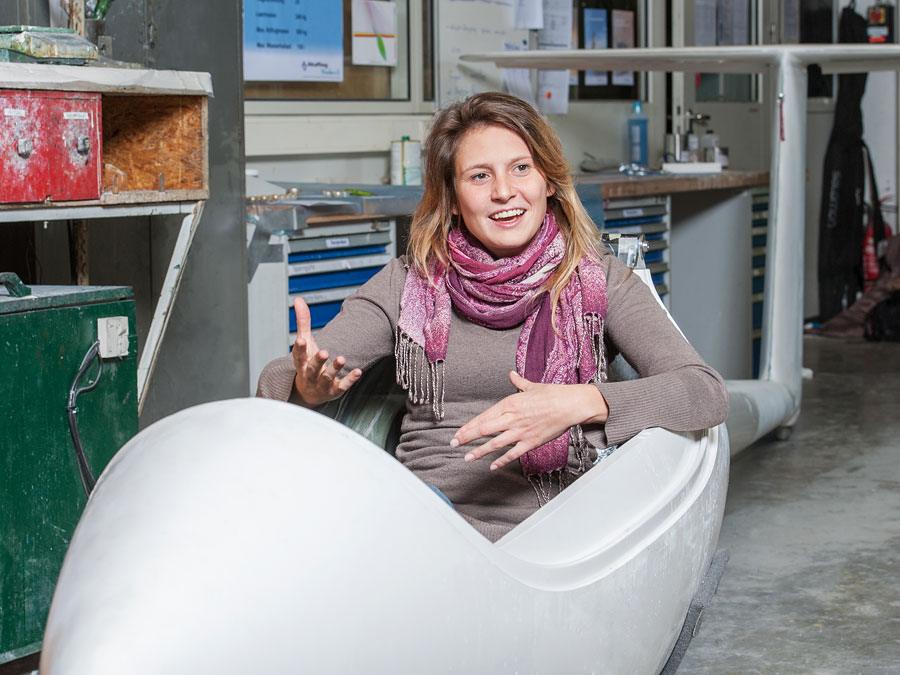Akaflieg: 90 years!
The ups and downs of gliding

Katja, what does Akaflieg do exactly?
Schmid: We are a group of students that focuses on designing, building and flying gliders. Currently, we are working on the completion of our Mü31, Akaflieg Munich's 31st prototype. Apart from the tasks in the workshop, many of us are already developing Mü32, which will be a new aerobatics aircraft. In the warmer months, we also spend a lot of time at the airport, where we fly ourselves.
How did you come across Akaflieg?
Schmid: All university groups presented themselves at the introductory event for freshmen; that’s where I first heard of Akaflieg. I had already been thinking about getting a license for motorized aircraft long before and thought that the group's work sounded really exciting. I joined fairly soon after that. Now, I've been a member for more than four years – and it's still a lot of fun.
You are part of the organizing team. What are your responsibilities?
Schmid: I am now responsible for the last prototype, the Mü30 "Schlacro", since a year ago. It is an aerobatic airplane that was built a few years ago, although Akaflieg usually only constructs gliders. We use the Schlacro as a tow plane to pull gliders into the air. I take care of the aircraft's operation, which naturally includes all the maintenance work, but also regular visits to trade fairs and sponsorship-issues.
The "Mü 31" will be completed soon. What is it that's so special about it – and how much work is needed to construct a flyable prototype?
Schmid: Akaflieg aims to explore or develop something new in each of the prototypes. The novelty of the Mü31 is its connection between the fuselage and the wing. Based on a standard aircraft, we placed the wings higher up and thus developed a shoulder-wing monoplane, reducing the resistance at the connection between the wings and the fuselage. As a result, we achieved a more efficient gliding phase, which is very important for gliders to stay in the air as long as possible. The first term-paper on the prototype was written back in 1999 – and we have since been busy developing and building the plane.
By when will you have completed the Mü 31?
We think we will be able to schedule the first flight some time next year, in 2015. Of course, we will only know for sure when the plane is assembled and all the official documents are issued. Right now, however, everything seems to be working out well.
You invest more than 300 hours for Akaflieg every year. What is it that motivates you and what do you like about the work so much?
Schmid: The fact that we organize projects ourselves and are gathering lots of practical experience. Gliding is a team sport – I really appreciate that too. And, of course, the flying itself is just unbelievable. When the plane is accelerated and I'm pressed into the seat, this causes a stomach-feeling similar to being on a swing as a child; absolutely beautiful. And because our airfield is located to the south of Munich, we fly in the foothills of the Alps and thus have a totally awesome view.
(Interview: Sabrina Czechofsky)
Katja Schmid, 25, is in her 9th semester of Aerospace Engineering at TUM. She has been flying herself for two years. For her, it is now almost a must that her future job will have to do with flying. It would be hard to imagine, she says, to be sitting behind a desk and watch others fly.
The university group Akaflieg was founded by four TUM professors in July 1924. The aim was to establish an "Academic Aviation Group" (Akademische Fliegergruppe, "Akaflieg" in short), to learn how to fly and to promote the development of gliders. Every student registered at a university in Munich can participate in Akaflieg. The membership is free – but the members must work 300 hours a year for Akaflieg to be able to obtain a flight authorization. Among other things, the group currently holds six flyable prototypes. "Mü", by the way, stands for "Munich", followed by the sequential project number.